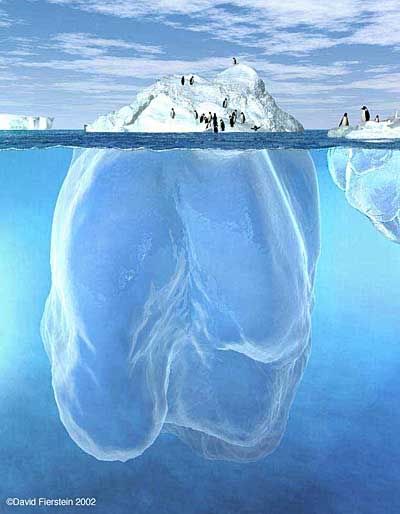(10AM – promoted by TheMomCat)
Healthy Economies are based on Minimizing Costs, while Maximizing the Social Benefits. Or at least they should be.
Yet our Corporate-driven Economic system, far too often focuses on Discounting the Costs, while Maximizing their Profits. Profits for the enlightened owners, NOT for Society at large. Both the long-term and local Costs, generally get swept under the rug, in such a competitive landscape.
And that is a recipe for long-term Planetary Disaster.
Every economic transaction is some sort of trade-off between Cost vs Benefits. Problems arise however, when most of those Costs (to the Planet and to Society) remain Hidden, just below the surface — completely “External” to any quick-hit P&L calculations and Statements.

The accurate Pricing of such “External” factors — both short-term and long-term — is KEY to whether or not, WE leave the world a better place than we found it.
“Externalities” have a way of creeping up on you, and “extracting payment”, sometimes when you least expect it.
from eoearth.org
Externality
Content Partner: Global Development and Environment Institute
Contributing Author: Tom Tietenberg
Lead Author: Neva R. Goodwin
Article Topic: Environmental economics
Last Updated: November 20, 2008
— A negative externality (sometimes referred to as an “external cost”) exists when an economic actor produces an economic cost but does not fully pay that cost. A well-known example is the manufacturing firm that dumps pollutants in a river, decreasing water quality downstream.
— A positive externality (sometimes referred to as an “external benefit”) exists when an economic actor produces an economic benefit but does not reap the full reward from that benefit. Positive externalities are less well-known, but can be vitally important to individual and societal well-being. A landowner, for example, by choosing not to develop her land might preserve a water recharge source for an aquifer shared by the entire local community.
[…]When a market transaction affects the welfare of third parties who are not involved in the transaction, the market behavior of the economic actors will not reflect all the preferences of, or all the costs to, everyone affected. This is because the costs or benefits affecting the particular actors differ from the costs or benefits to society as a whole. For example:
— If the cost of polluting is not borne by the polluters, they will not feel an economic motivation to reduce their creation and discharge of wastes.
— If the price of water or of petroleum is set below the true cost to society of using these resources, this will produce an incentive to use too much of them.
[…]
In general, each of these examples involves a situation in which there is a difference between private and social costs (or benefits); as a result, the monetary incentives of the marketplace encourage socially undesirable behavior.[…] But we live in a social and ecological world, in which actions, interactions, and consequences are generally both widespread and interknit. If decisions are left purely to individual self-interest, then from a societal point of view too many negative externalities will be created, and too few positive externalities […]
Relying on markets alone to coordinate economic activities allows many activities to happen that damage or deplete the natural environment, because the damage often does not carry a price tag, and because people in future generations, who will be most affected, are not direct parties to the decision-making.
Negative “Externalities” (Social Costs) have a way of creeping up on you, and “extracting payment”, sometimes when you least expect it.
Sometimes it even skips a generation … BUT someone always ends up paying the long-term price … (it could even end up being “someone”, in some “future generation” that you might care about.)
SO what kind of the External Costs, will that “Future US”, be looking forward to, assuming we continue on the “Status Quo” Path, of too little, too late?
ie. What IS the Real Cost of Inaction, with regards to Climate Change?
Climate Change – the Costs of Inaction (pdf)
Report to Friends of the Earth England, Wales and Northern Ireland
Frank Ackerman and Elizabeth Stanton
Global Development and Environment Institute,
Tufts University – -October 11, 2006
Executive Summary
This report examines the costs of inaction – the worsening damages that will result from allowing climate change to continue unabated. Economic models have estimated damages as great as US$74 trillion, but even these numbers fail to convey the multiple harms that lie in store for the world.
[…]The climate system, and our economic activities that affect it, have enormous momentum. It is not possible to wait until the world begins to get uncomfortably warm, and then suddenly decide to stop. Because of its momentum, a supertanker has to turn off its engines 25 km before it comes to a stop. Likewise, we have to achieve a drastic reduction in carbon emissions several decades before we can bring climate change under control. In other words, we have to take action long before we experience the full severity of the problem. The world as a whole can, just barely, cope with the impacts of the first 2° of warming, but only if there are immediate, large-scale, and creative approaches to international equity and cooperation.
[…]Categorizing climate risks
Scientists’ models of climate change predict not only increases in average temperature, but also increased variability of weather conditions and more extreme events, including more droughts and floods, more heat waves, more powerful storms:
— Recent climate change has already made extreme heat waves two to four times more likely, and over the next 40 years, extreme heat events will become 100 times more likely than in the late 20th century.
— Climate change is increasing the frequency and intensity of extreme weather, causing a sharp upswing in damages. In 2005, natural catastrophes caused US$220 billion worth of damage worldwide.
— In addition to property damages, there are losses of income for months or years after extreme weather events. The U.S. state of Louisiana, the area hardest hit by the extraordinary hurricanes of 2005, suffered a 15 percent loss of income for the post-hurricane months.
Lurking beyond the problem of extreme weather events is the risk of a climate catastrophe:
— Increasing temperatures raise the probability of collapse, followed by rapid melting, of gigantic ice sheets in Greenland and/or Antarctica, which could cause a devastating sea-level rise.
— Even more moderate melting in Greenland and the Arctic could potentially disrupt the circulation of ocean currents in the North Atlantic, which is responsible for the relatively mild temperatures of Northern Europe.
— In addition, there is a danger that gradual warming could lead to abrupt releases of large quantities of the methane – a greenhouse gas more powerful than carbon dioxide – that is currently stored in frozen, but quickly thawing, tundra; this would greatly accelerate the process of warming.
Sounds Expensive.
In the long run, someone — the Future Citizens of Earth — will end up paying in the neighborhood of US$74 Trillion — if we OUR Economic system, continues to fail to “account for” the Environmental damage, our economic transactions, continue to pile up, each and every day.
Sooner or later someone will Pay the Price.
Kind of puts into perspective that EURO400 Billion Price Tag, of the Europe’s Desertec project [pdf], to tap the Sun, Wind, and Earth.

It’s peanuts really. One could call it a very shrewd, long-term Economic Investment.
Spend $536,000,000,000 Now, [400 Euro x 1.3204 U.S. dollars]
Avoid $74,000,000,000,000 in External Hidden Costs, later.
Europe is taking “costly” steps to “course correct” its Energy Vessel. These enlightened Citizens of Earth see the “value” of creating some Positive Externalities (Social Benefits), for their long run future well-being:
DESERTEC gets serious — Teams up with First Solar
by jamess — Mar 20, 2010
And the USA is grudgingly following suit, dipping a few toes in the water, in a fledgling attempt to “slow down”, and re-direct OUR giantic Energy “ship” of state:
Solar Zones on the US Energy Drawing Boards
by jamess — Mar 18, 2010
Let’s hope those DOE and DOI efforts are more than token gestures. Let’s hope its not “too little, too late”, which has been far too typcial of America’s near-sighted “capitalistic me-first investments”.
Because “inaction” has a Real Cost too. And an Energy Economy cannot be turned on a dime. It takes planning, and innovation, and leadership. Above all it takes foresight to see the Hidden Costs, that lie waiting in our path … and taking ACTION NOW to avoid those “unseen” Economic Icebergs and Reefs, in our path.
It’s a pay now or pay later scenario. Guess which choice, third-level tier players make?
Until true Cost Accounting is applied to our Global (and Local) Economies, the inevitable planetary “reconciling of the books”, will keep getting postponed til “some later date”. Until it’s much too late to adequately “Minimize those Costs, while Maximizing the Benefits”, for the World at large. Momentum is funny that way. It takes significant lead time, to change the inertia of a ship like the Titanic or the Exxon Valdez, as experience has shown.

Spaceship Earth has such a long run Momentum trajectory too. It can not be turned on a dime. It’s time we all put in our oars. Pull our own “energy” weight.

It’s time to go further, faster … daylight is a burning …
We had better start calculating conversing in the terms of long run Social Costs vs long run Social Benefits, if we are to have any hope of avoiding the numerous Ecologic Icebergs and Reefs, lying in wait, just around that next economic bend.


4 comments
Skip to comment form
Author
U.S. Approves First Offshore Wind Farm Near Cape Cod (Update3)
http://www.businessweek.com/ne…
the Social Benefits from projects like this, will last for generations.
I hope this positive trend continues.
of the two major political parties?
They can do it, can the US?
http://en.wikipedia.org/wiki/S…